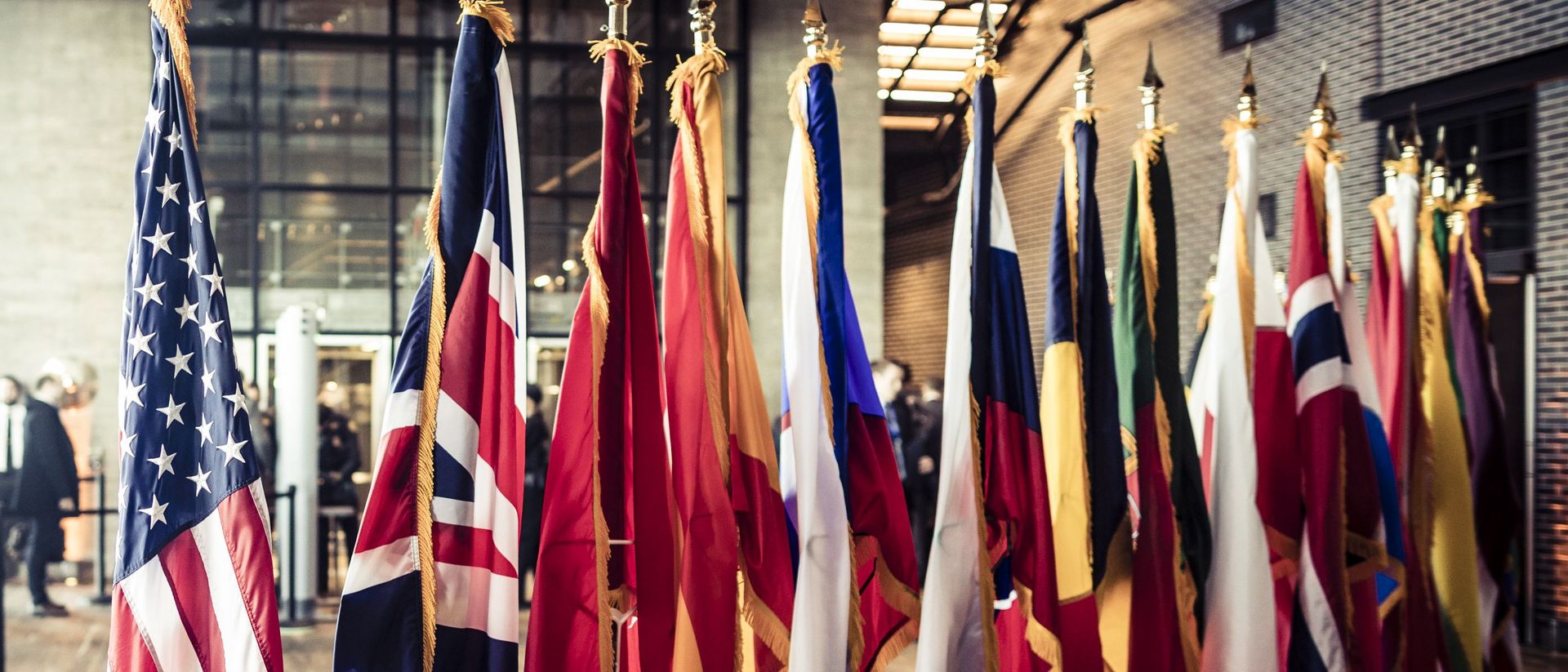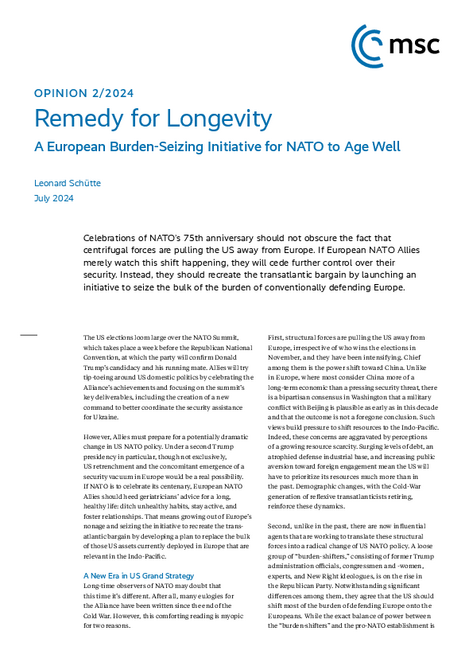

Remedy for Longevity
A European Burden-Seizing Initiative for NATO to Age Well
 AuthorLeonard Schütte
AuthorLeonard Schütte
 AuthorLeonard Schütte
AuthorLeonard Schütte
The US elections loom large over the NATO Summit, which takes place a week before the Republican National Convention, at which the party will confirm Donald Trump’s candidacy and his running mate. Allies will try tip-toeing around US domestic politics by celebrating the Alliance’s achievements and focusing on the summit’s key deliverables, including the creation of a new command to better coordinate the security assistance for Ukraine.
However, Allies must prepare for a potentially dramatic change in US NATO policy. Under a second Trump presidency in particular, though not exclusively, US retrenchment and the concomitant emergence of a security vacuum in Europe would be a real possibility. If NATO is to celebrate its centenary, European NATO Allies should heed geriatricians’ advice for a long, healthy life: ditch unhealthy habits, stay active, and foster relationships. That means growing out of Europe’s nonage and seizing the initiative to recreate the trans-atlantic bargain by developing a plan to replace the bulk of those US assets currently deployed in Europe that are relevant in the Indo-Pacific.
A New Era in US Grand Strategy
Long-time observers of NATO may doubt that this time it’s different. After all, many eulogies for the Alliance have been written since the end of the Cold War. However, this comforting reading is myopic for two reasons.
First, structural forces are pulling the US away from Europe, irrespective of who wins the elections in November, and they have been intensifying. Chief among them is the power shift toward China. Unlike in Europe, where most consider China more of a long-term economic than a pressing security threat, there is a bipartisan consensus in Washington that a military conflict with Beijing is plausible as early as in this decade and that the outcome is not a foregone conclusion. Such views build pressure to shift resources to the Indo-Pacific. Indeed, these concerns are aggravated by perceptions of a growing resource scarcity. Surging levels of debt, an atrophied defense industrial base, and increasing public aversion toward foreign engagement mean the US will have to prioritize its resources much more than in the past. Demographic changes, with the Cold-War generation of reflexive transatlanticists retiring, reinforce these dynamics.
Second, unlike in the past, there are now influential agents that are working to translate these structural forces into a radical change of US NATO policy. A loose group of “burden-shifters,” consisting of former Trump administration officials, congressmen and -women, experts, and New Right ideologues, is on the rise in the Republican Party. Notwithstanding significant differences among them, they agree that the US should shift most of the burden of defending Europe onto the Europeans. While the exact balance of power between the “burden-shifters” and the pro-NATO establishment is unclear, the voting record on the Ukraine supplemental in Congress suggests that arguments in favor of dramatically reducing the US footprint in Europe already resonate with at least half the Republican caucus. And the outcomes of the Republican primaries so far indicate that the “burden-shifters” may even be more prominently represented in Congress after the elections. Trump would thus have much stronger support in his party for radical policy change on NATO than during his first term.
NATO on Life Support
Private conversations with the “burden-shifters” and their public interventions provide clues as to what such a radically new US NATO policy may look like. Almost none of them actually advocates for a formal US withdrawal from NATO or the end of the US nuclear security guarantee. This is the only piece of good news for Europeans though. Because in line with former President Trump’s public comments, the “burden- shifters” want to condition the collective defense clause by extending the US security umbrella only to deserving allies – supposedly judged by their defense spending but perhaps also alignment on other issues. Such a two-tiered alliance model would seriously jeopardize NATO’s credibility and shake its very foundations.
European NATO Allies need to accept the direction of travel of US security policy and seize the initiative to shape the future of NATO.
Leonard Schütte•Munich Security Opinion 2/2024: Remedy for Longevity
Moreover, they are crafting plans to withdraw US troops and military capabilities from Europe to strengthen the US deterrence posture in the Indo-Pacific and incentivize higher European defense spending. These plans include resuscitating former President Trump’s idea to withdraw 12,000 troops from Germany and drawdown those troops deployed since February 2022. Other troops that could operate in the Indo-Pacific would be next. Military analysts disagree on the extent to which US capabilities currently deployed in Europe are relevant in the Indo-Pacific. But it is fairly uncontroversial that aircraft, ships, long-range fires, munition, and air-defense systems would be useful, and those would be the first to be withdrawn. The real danger is that such withdrawals could create a security vacuum in Europe as it would critically undermine the European NATO Allies’ ability to sustain combat operations and thereby NATO’s deterrence posture vis-à-vis Russia. NATO would de facto be on life support.
Growing Out of Europe’s Nonage
This scenario is plausible but not predestined. An overhaul of US grand strategy is more likely under a President Trump than a President Biden, at least in the short term. It is also more likely if tensions between the US and China persist. In the event of a military contingency, even a President Biden would be compelled to shift resources to the region.
But European NATO Allies still have influence, too. They need to accept the direction of travel of US security policy and seize the initiative to shape the future of NATO. To do so, they should launch a European Burden-Seizing Initiative to shoulder the bulk of Europe’s conventional defense to pre-empt the risk of a security vacuum and generate goodwill in the US. In light of Europe’s vast existing capability gaps, which last year’s Munich Security Report Special Edition on European Defense detailed, additionally replacing US assets in Europe is a momentous task. To prioritize, European policymakers should ask three questions. First, which capabilities are useful for territorial defense? Second, which capabilities are relevant in the Indo-Pacific? And third, which capabilities are readily substitutable by existing European capabilities, off-the-shelf procurement, or near-term European development? European NATO Allies should then set out an ambitious timeline for replacing those assets that are valuable for the defense of Europe, possess relevance in the Indo-Pacific, and can be substituted. Such an initiative – alongside higher defense spending – would strengthen the case to persuade US policymakers not to withdraw those assets that Europeans absolutely cannot replace but rely on.
It is time for European Allies to grow up and seize proportionate responsibility for defending Europe. Only then will NATO live to a ripe old age.

Remedy for Longevity: A European Burden-Seizing Initiative for NATO to Age Well
Leonard Schütte, “Remedy for Longevity: A European Burden-Seizing Initiative for NATO to Age Well,” Munich: Munich Security Conference, Munich Security Opinion 2, July 2024, https://doi.org/10.47342/GEGG7367.
Download PDF 67 KB